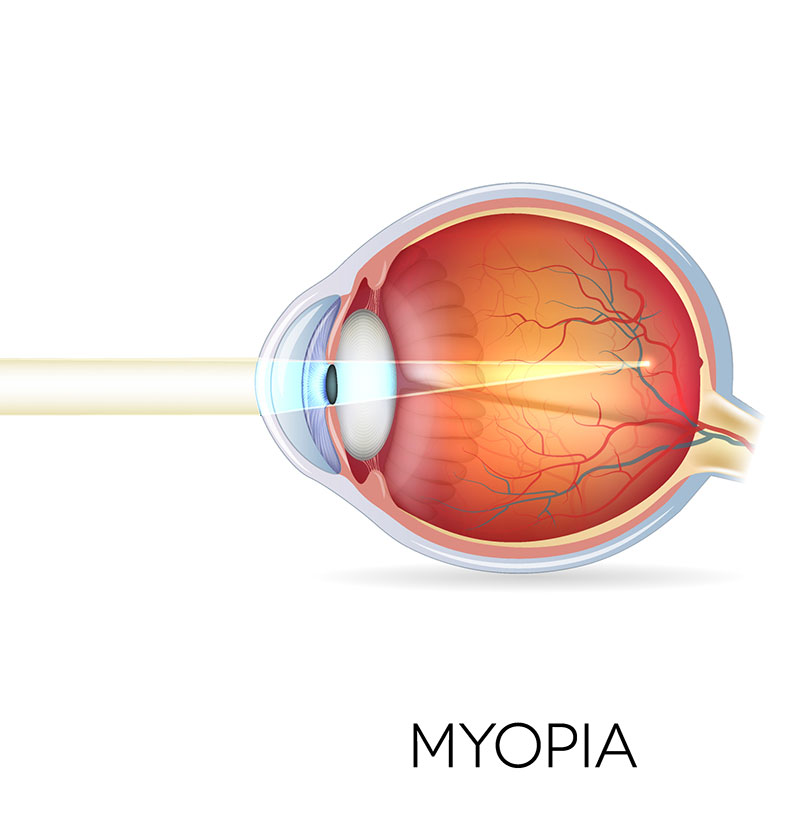Myopia (or short sightedness) is a common eye condition that causes the patient to see distant objects as blurred, despite seeing their close surroundings very clearly. Glasses, contact lenses and laser eye surgery are all recognised ways of correcting myopia.
What is myopia?
Myopia is also known as near-sightedness or short-sightedness and is one of the most common eye conditions affecting all sections of the population.
It occurs when a patient’s eye is either too long or the cornea is too curved, or a combination of the two. In a myopic patient, light is focused in front of the retina at the back of the eye, instead of to a sharp focus onto the retina. This means that when they look at distant objects, a blurred image is sent to the brain.
Myopia can be mild, moderate or severe (high myopia).

What are the symptoms of myopia?
Myopia often starts to develop in childhood or adolescence, although it can start at any age.
If you have trouble seeing objects at a distance, you are probably short-sighted. People with myopia suffer from blurred distance vision that is worse at night or in dusk-like conditions, although their near vision will be very good.
Patients with myopia symptoms may try to “screw up” their eyes in the early stages to try and compensate for their blurred vision, but without optical correction, there is no way of compensating or overcoming this visual disorder.
People with uncorrected short sight may also suffer from headaches.
If you have trouble seeing objects at distance and would like to discuss myopia treatment options, make an enquiry or call us on (02) 9452 6444.
What are the causes of myopia?
Age is one of the most common factors in myopia development, although there are several other influencing factors.
- Age: the degree of myopia increases with increases in eye length, so this condition has a trend to worsen during puberty when growth is at a maximum
- Regular close-up reading (on a computer or paper) and inadequate exposure to sunlight during childhood
- Diabetes
- Some types of cataract
- Familial factors
What are the treatment options for myopia?
Non-surgical treatment options
Glasses and contact lenses in the form of negative lenses are all recognised ways of correcting myopia.
Another myopia treatment, orthokeratology (ortho K), involves the wearing of rigid contact lenses overnight which alter (flatten) the shape of the cornea to reduce the overall power of the eye and decrease the degree of myopia. The change in shape induced by these contact lenses lasts around 1 to 2 days, and for a longer effect, lenses need to be worn more regularly. It may be suitable for mild to moderate degrees of myopia. It works by starving your cornea of oxygen which stresses the tissue and causes it to swell and change shape. The long-term effects of this treatment are not known.
Surgical treatment options
The type of surgical correction that is most suited to you will depend on a number of different factors that will be considered by your eye surgeon, including your age, the degree of short sight you have, the thickness of your corneas and any other co-existing ocular conditions that you may have.
Laser eye surgery
Involves reshaping the cornea using lasers, correcting the way the eye focuses light. A popular procedure that will usually correct an individual’s vision until they develop reading vision difficulties in their 40s when they will require reading glasses.
Lens implant surgery
Involves inserting an implantable contact lens into the eye behind the cornea to help correct vision. This option is best suited to people who are unsuitable for laser eye surgery or those with dry eye or very high levels of short sight.
Clear Lens Extraction
The same as cataract surgery but involves the removal of a clear crystalline lens (with no cataract) and replacement with a multifocal lens. This is an option that may be better suited to people over the age of 45.
Read more about refractive lens exchange surgery at Forest Eye Surgery
All surgical procedures carry some risk. The information provided here is for general educational purposes only. Please contact Forest Eye Surgery to find out if refractive lens exchange surgery is appropriate for your individual situation.
For appointments and enquiries call (02) 9452 6444
Our rooms are open 8:30 am - 5:00 pm Monday to Friday
Unit 11, Building 7
49 Frenchs Forest Rd East
Frenchs Forest NSW 2086
info@foresteyesurgery.com.au
Phone: (02) 9452 6444
Fax: (02) 9452 6566
